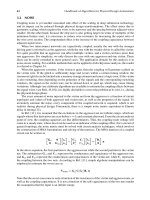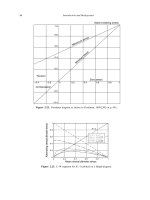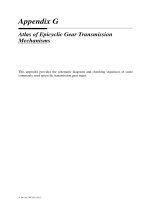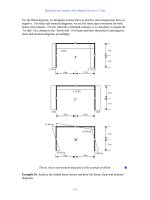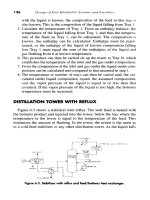Recycling of Plastic Materials Part 7 ppsx
Bạn đang xem bản rút gọn của tài liệu. Xem và tải ngay bản đầy đủ của tài liệu tại đây (527.52 KB, 17 trang )
F.P. La Mantia, C. Perrone and E. Bellio 95
Figure 12. Modulus vs. PE content for blends having varying content of LDPE and CaCO
3
.
Figure 13. Tensile strength vs. PE content for blends having varying content of LDPE and CaCO
3
.
96 Blends of Polyethylenes and Plastics Waste
Figure 14. Elongation at break vs. PE content for blends having varying content of LDPE and
CaCO
3
.
Figure 15. Impact strength vs. PE content for blends having varying content of LDPE and CaCO
3
.
could be the same as the above proposed to interpret the small sensitivity of
these properties to the MPW concentration. Elongation at break and impact
strength of blends with LDPE and RPE decrease slightly only by adding 10%
CaCO
3
. A 20% addition of calcium carbonate significantly decreases elongation
and impact strength of blends. The elongation at break and impact strength
drastically deteriorate on addition of 10% CaCO
3
to HDPE blends.
Blends containing LDPE
On thebasis ofthe aboveresults, blendsmade fromLDPE withlarger amounts
of MPW were prepared. It is worth noticing that all blends previously character-
ized were composed of polyethylene matrix (PE > 50%) with dispersed PET and
PVC particles. Blends with larger amounts of MPW show a PE content lower
than 50%.
The mechanical properties of LDPE/MPW blends with and without calcium
carbonate are reported in Figures 12-15 as a function of the polyethylene con-
tent. The total amount of polyethylene was evaluated considering the polyethyl-
ene in the plastics waste (about 33%).
The modulus increases with the MPW and is only slightly influenced by the
CaCO
3
content. As already discussed, the tensile strength does not significantly
change with decreasing the PEand CaCO
3
content. The elongation at breakrap-
idly decreases even at a low content of plastics waste (for PE content lower than
70% theinfluence ofCaCO
3
is negligible).At highPE contents,CaCO
3
seems im-
proving the elongation at break. It is however worth noticing that the compari-
son is not made for the same MPW content. The data for PE = 80% (graph for
20% CaCO
3
) refers to a blend without plastics waste showing that the effect of
the heterogeneous plastics waste is more deleterious for the elongation at break
of the polyethylene than that of the CaCO
3
addition.
The impact strength, on the contrary, strongly depends on the presence of
CaCO
3
. With increasing the CaCO
3
concentration, the amount of MPW at which
the impact strength declines decreases. Whereas at CaCO
3
= 0%, impact
strength diminishes at a PE content lower than 40%, at a concentration of
CaCO
3
= 20%, impact strength is considerably reduced at a PE content lower
than 70%.
F.P. La Mantia, C. Perrone and E. Bellio 97
CONCLUSIONS
• Blends of polyethylene with mixed plastics waste, up to 50-75%, can be ex-
truded without significant difficulties and accelerated degradation of the
PVC component.
• The mechanical properties depend on the structure of the polyethylene ma-
trix, but, in general, are very similar to those of the matrix up to a MPW
content of about 25-50%.
• The elongation at break rapidly decreases even at low MPW content; how-
ever, in many applications this characteristic is not very important and the
values recorded for blends under the study can be considered adequate.
• Considering polyethylenes tested in these blends, LDPE and polyethylene
recycled from greenhouse films gave the best results.
• The additionof CaCO
3
, upto 10% content, does not significantly change the
processability and the mechanical properties of blends but the cost of the
blends is reduced because of replacing a corresponding amount of
polyethylene.
ACKNOWLEDGMENT
This work was financially supported by MURST and Enichem Polimeri.
REFERENCES
1. Plastic Waste: Resource Recovery and Recycling in Japan. Plastic Waste
Management Institute, Tokyo, Japan 1985.
2. F. P. La Mantia, Polym. Deg. Stab., 37, 145 (1992).
98 Blends of Polyethylenes and Plastics Waste
Techniques for Selection and Recycle
of Post-Consumer Bottles
E. Sereni
Tecoplast and Govoni, 44047 Casumaro, Ferrara, Italy
INTRODUCTION
Techniques for selection and recycling of post-consumer plastics are closely re-
lated to the characteristics of plastic containers consumption, which are ex-
tremely diversified according to the geographical areas and the relevant law
regulations governing activities in this sector.
In each area, socio-economic and legislative features as a whole determine the
first stage of the recycling process, that is collection. This, in turn, influences the
layout of the recycling plant which aims at the re-use of plastic materials re-
claimed in the most economical way.
Hence theenactment of laws which bind municipalities to recycle containers in
general, as is the case in Germany, or in a more restrictive sense, in Italy, where
recycle is limited to containers for liquids only.
On the other hand, consumption features play a major role in the choice of the
materials to be recycled. So, in the United States materials chiefly recycled are
PET bottles and PE containers; in France, on the contrary, they began to recycle
PVC on account of the large quantity of such material used in the packaging of
drinks. In Australia recycling includes PET and PE, whereas in Japan PET
alone. In Italy plastics recycled are PET, PVC and PE.
In short, the material to be recycled and the enforced legislation are determi-
nants for the choice of the collection system. In the United States, Australia,
France, Austria and Switzerland, different fractions of post-consumer plastics
are collected in the most homogeneous way possible.
In other countries, on the contrary, plastics are collected more heteroge-
neously, that is to say, different types of plastics out of different types of manu-
factured articles, such as foil, containers, bottles, are collected together.
E. Sereni 99
At any rate, collection must necessarily be a “differentiated” one, although the
degree of differentiation may vary extremely. In Italy, collection, according to
Law 475, is differentiated as far as recycle of plastic containers is concerned,
whereas it is non-differentiated with regards to type of plastics, since liquids
containers may be made of either PVC, or PET, or PE, or else.
The outcome of the collection system, therefore, constitutes the raw material
for the recycling process. Consequently, as we are taught by experience in this
field, the more selective the collection, the higher the degree of purity from for-
eign bodies in the final product.
In Italy, for instance, collection of liquid containers by means of plastic boxes,
shows 15% to 20% contamination resulting from foreign bodies. Collection of
drink containers carried out with the AZURE-Bottle-eater - an automatic ma-
chine installed inside supermarkets presents pollutants solely composed of
other types of containers, and not exceeding 1%.
Aim of this paper is to present the more recent technologies of automatic sepa-
ration of plastic items. A brief paragraph on a typical recycling plant of homoge-
neous plastics is also presented.
GENERAL CONSIDERATIONS
The collection always yields a polluted product, and this fact poses the need for
the first operation of the recycling process, namely the cleaning of foreign bod-
ies. The machinery required at this stage may be of either manual or automatic
type. Manual cleaning is simpler from the installation standpoint, nevertheless
it equally requires a number of operating steps. Normally, the first operation is
carried out by a machine called de-baler. The collected material, indeed, for
transport cost reasons, is reduced into bales. There exist very efficient de-balers
and the best brands have been equipped with specific devices designed in accor-
dance to the composition of the bales to be loosed.
Such factors as the proportion of PVC, PET or PE in the bales, the collection
features, the container typology, and the share of foil plastics, determine the
type of de-baler construction technique.
After the first step, the following operations are determined by the type of recy-
cling process to which the material is to be subjected. Basically there are two
main recycling processes:
• recycle of heterogeneous plastics
• recycle of selected polymers.
100 Techniques for Selection and Recycle of Bottles
The former technique consists of the manufacture of extruded or injected prod-
ucts, whose main component is either PE or PVC, whereas other plastics act as
fillers. Thelatter consistsof separationof the mix of collected plastics into homo-
geneous fractions, subjected to a recycling process which brings their character-
istics and purity as near as possible to those of original polymers. The two
techniques are not contrasting, in fact they can be regarded as complementary
to each other.
The polymers recycling process is the technique an industry is the most con-
cerned with. Attention is called to the fact that the utmost degree of purity of the
finished product should be aimed at, because reclaiming process requires vari-
ous plant operations determinant for the final cost of the material. The differ-
ence in outcome - namely a product similar to the original one or a polluted
product - does not entail such a difference in installation and operating costs as
there may be between the price of an optimum product and that of a lower-qual-
ity product. If this is true for every type of plastics, it is the more so for the PET,
which, if it is not recycled tothe utmostlevel of quality, has virtually nomarket.
The cleaning of foreign bodies to obtain recycled plastics as polymers is fol-
lowed by the selection by fractions which can be carried out as well with manual
or automatic techniques. Cleaning and selection operations, in general, have the
purpose to obtain a selected material to be “refined” by processing it through a
recycling plant. The process of cleaning and selection has therefore the function
to remove, during this stage, all materials that cannot be selected during the re-
cycling process. It is therefore necessary to eliminate in advance metals and for-
eign bodies and sort out plastics presenting such physical affinity with the type
of plasticto be recycled as to make it impossible to separate themby themethods
employed in the recycling process. Typical is the case of PET and PVC, which
contaminate each other mutually and have very similar specific weights. As a
consequence, they cannot be separated through such ordinary physical pro-
cesses as water flotation and, therefore, must be separated prior to recycling.
The simplest method to perform the cleaning and selection operation consists
of a selection platform where a number of trained sorters separate the different
types of plastics on the basis of visual assessment. This is a hard and unpleasant
job. Therefore, planning of works station according to ergonometric criteria is
paramount in order to attain manpower’s maximum efficiency, the more soif the
cost of labor is considered.To the advantage of manual selection is the fact that
E. Sereni 101
not reach. On the other hand, manual selection is comprehensibly always liable
to human error. For this reason, inItaly, selection platforms, which are being in-
stalled, are equipped with detectors to checkthe qualityof the selected material.
The detectors employed in Italy are the clue to the automatic selection. These
are electronic appliances capable of recognizing PET in a flux of PVC and vice
versa. The checking equipment is further completed by detectors able to identify
traces of metal overlooked during manual sorting, such as aluminum from caps
and rings. The material manually selected and then electronically checked is
therefore of best quality and can be sold at the maximum market price.
The most serious inconvenience with manual platforms lies in the high cost of
labor and in the complexity that the management of a large number of workers
poses when considerable quantities of material are to be selected. Such draw-
backs may be avoided by resorting to automatic platforms. Automation is intro-
duced at the stage of de-baling. In order to obtain a product suitable for the
recycling process, operations to remove undesired impurities must be carried
out. The machines required are manifold and the necessity to employ them is re-
lated to the quality of the collected material.
Essential machines are:
• Rotary screen, by which parts of the desired dimension are sorted out, sepa-
rating them from smaller and larger ones.
• Light-parts separation equipment. In this machine lighter parts, such as
for example films, are separated from the plastic material to be recycled.
The method of separation is by air blowing.
• Heavy-parts separation equipment. Also this operation is carried out by
means of air which shifts the material selectively, so that heavy particles
are separated.
• Aluminum rejection equipment. It normally consists of an electromagnetic
drum placed in suitable location on the train of operations.
All such machines are preliminary to the stage of selection into homogeneous
plastics fractions.
102 Techniques for Selection and Recycle of Bottles
sorters operate to such a degree of intelligence as the automatic equipment can-
• Molecular separation
• Microseparation
• Macroseparation.
MOLECULAR SEPARATION
This type of selection is still inthe stage of study and there is no evidence of any
industrial plant in operation so far. The technique is based on the dissolution of
the various plastics in selective solvents with reclaim of the dissolved sub-
stances. The system appears to be very promising, but no moredetailed informa-
tion is currently available.
MICROSEPARATION
Microseparation is a method by which a suspension medium is used to sepa-
rate plastics with density higher or lower than the suspension medium. For ex-
ample, water can be used as medium to separate PE from PVC or PET.
In this case special tanks are used in which various types of plastic flakes are
mixed with water and then given a sufficient time to position themselves in the
most suitable way according to their density. Materials are subsequently ex-
tracted separately from the top or bottom. This method is not suitable for sepa-
rating PVC from PET.
Researchers at the Rutgers University
1
studied a method of PVC
microseparation from PET, by which PVC is subjected to a process of selective
bulking which causes it to float. Such method may perhaps be applied in the fu-
ture to separate small quantities of PVC from large quantities of PET, as nor-
mally is the case in United States. In Italy, for example, PVC is a major
component of the containers mix and, therefore, it is necessary not only to sepa-
rate PET, but also to recycle PVC for re-use. For this reason the above method
does not appear suitable.
There are known experiments on separation in super critical fluids. Beckman
2
reported separation of PVC and PET, using carbon dioxide and sulphur
esofluoride. The conditions under which experiment was conducted are objec-
tively difficult and, at present, an application of this method is not practical.
The electrostatic separation is presently arising great expectations. By ex-
ploiting the characteristics of the triboelectrical charge, two mixed polymers ob-
tain opposite charges. The particles, which are allowed to fall in electromagnetic
E. Sereni 103
Selection can be carried out by different methods which fall mainly into three
groups:
field, are attracted by to the opposed pole. The equipment recently shown by
Kali and Saltz
3
and Carpco
4
let us reasonably predict encouraging results. How-
ever, prior to the industrial introduction of the method described above, it will
be necessary to make an accurate assessment of the final cost of treatment and
to evaluate whether the conditions under which the system is efficient are those
actually encountered in the treatment of post-consumer plastics.
One should also mention some other studies and experiments conducted by
various institutes regarding techniques applicable to PVC and PET containers,
previously reduced to flakes, namely: flotation with surface active agents and
separation by thermal treatment, which enables to retain PVC by its softening
on a belt having a suitable temperature.
Decontamination is already applied in practice, the most frequently by
micronization which takes advantage of a higher brittleness of PVC as com-
pared to PET. Such grinding produces PVC particles of smaller size than those
of PET. Consequently PVC can be separated by screening with a satisfactory de-
gree of efficiency. The method is employed in Micronil, France and Cabot in Bel-
gium. Low-temperature micronization techniques, used in Australia by
Cryogrind, do not appear useful in Europe because of a high energy cost in-
volved.
MACROSEPARATION
Separation of plastic fractions when waste materials are still in initial form
continues to appear the most conveniently applicable system, considering the
increasing possibilities of automation it offers. It is of little interest as long as
separation is manual, but it becomes worth discussing when conducted by an
automatic separation process which includes various systems employing detec-
tors currently available in the market.
The first detector was developed by Tecoplast in Casumaro, Ferrara-Italy, to
separate PVC from PET. The application of this system resulted in the introduc-
tion of an automatic plant processing drink plastic bottles using the AZZURRA
machine. A peculiar composition of the collected material made it possible to
fully automate the operations of selection, thus totally excluding manual han-
dling of bottles.
The Tecoplast’s detector consists of an X-ray source and a receiver which mea-
sures the bottle absorption while passing between the source and receiver. PVC
has a higher absorption compared to the other plastics due to the presence of a
104 Techniques for Selection and Recycle of Bottles
chlorine atom. The value of PVC absorption, electronically processed through
algorithms, makes it possible to detect its presence and consequently to eject
bottle.
Another detectoris employed to line up bottles using a suction robot. The align-
ing process enables bottles tobe arranged in the most suitable fashion foridenti-
fication of transparency and color. Taking advantage of this technology,
Tecoplast developed the first optical detector capable of establishing the quality
of PET, thus determining the separation between clear PET and colored PET,
besides the mentioned separation from PVC. At present Govoni’s technology
employs detectors performing the above described operations without align-
ment.
Other detectors have been developed in the USA. ASOMA
1
built a detector
which identifies PVC by fluorescence induced to non-aligned bottles. These fall
through a chute at the end of which PVC detected bottles are extracted by a com-
pressed-air jet. The NRT detector
4
is based on the same principle and operates,
using bottles descending along atilted plane. An optical detector has been devel-
oped by the American MSS.
5
The machine is a part of a system consisting of PVC
detector to obtain separation into homogeneous material fractions, including
PVC, clear PET, colored PET, multicolored HDPE, translucent HDPE.
A near-infrared (NIR) spectrophotometry detector was been recently devel-
oped by AIC, Automation Industrial Control
6
for identification of the resin type.
The equipment is connected with another detector for color determination. The
resulting data are processed by computer with highly sophisticated software.
The equipment enables separation of a container mix into various components
with a high degree of selectivity in regard to typology and color. This type of de-
tector requires material singularization and lining-up.
All detection systems are based on techniques which in principle should be
highly accurate, almost infallible. In practice, however, this is not the case. As
known, for instance, PET with maximum admissible impurities of 100 ppm,
should have a PVC detector with 99,99% efficiency. In reality to reach this per-
centage is virtually impossible, because detection must be unfailingly followed
by rejection of the detected bottle, and this is not always the case either. There-
fore detectors with a more likely efficiency of 99,5%, but also 99% only, if in-
stalled in series and in number of at least two units, can bring the level of
impurities withinthe limitsrequired. Returningto the previous example: with a
mix in the proportion of 90% of PET and 10% of PVC, two detectors with 99,5%
E. Sereni 105
efficiency placed in series enable to obtain a level of impurities of 2,5 ppm,
whereas with efficiency of 99% the value of residue is 10 ppm.
A further point of consideration is the efficiency of separation which could nul-
lify all the above calculations. Experience has shown that the inefficiency of sep-
aration of the detected product is exceeding by far the detector inefficiency. For
instance, if the efficiency of PVC separation is 99%, in the former case 22,5 ppm
will be obtained, in the latter 400 ppm. Therefore, a check on the operations of
selection of the detected product is of primary importance.
106 Techniques for Selection and Recycle of Bottles
Figure 1. Automatic platform for plastics selection.
lustrated, which is a system developed by Govoni based on Tecoplast’s experi-
ence. It consists of a platform for selection according to plastics typology, where
all the identification steps are performed twice and where the efficiency of selec-
tion following detection is always subjected to check (Figure 1).
The notion of “error reduction” in the execution of an operation by a way of rep-
etition of the same step is adopted also in the phases of pre-cleaning of the parts
to be passed onto electronic selection.
In conclusion, we believe that the described system allows one to achieve the
aim of selection purity using an automatic equipment, having a sufficient de-
gree of reliability.
RECYCLE INSTALLATIONS
A special importance is generally devoted to the techniques of electronic selec-
tion of homogeneous fractions, while disregarding the phase of regeneration of
selected plastic flakes.
This minor interest would be justified if bottles were manufactured following
criteria of perfect recyclability. However, such criteria are not yet universally
accepted and complied with; therefore the recycling plant designer must give an
accurate response to the problems posed by various elements which normally
compose the item to be recycled. If we refer to liquid containers in general, these,
beside the body made out of plastic, consist of additional components which are
to be regarded as foreign bodies to be removed. Such elements are:
• caps made of: PE, PE with PVC gaskets, aluminum
• labels of tacky paper with different types of glue, composed of PE or PVC
• base cups of PEAD
• residues and dirt which may have been added during waste collection
phase.
Various operations, to be carried out in a specific sequence because of the prob-
lems posed by the type of material, are the following:
Grinding
It is the first step following selection. It requires attention and accuracy in de-
sign to ensure optimum homogeneity of the ground product.
E. Sereni 107
There is an all-Italian project, meeting all the primary prerequisites so far il-
Air flotation
Specially designed machines combining the effects of vibration and air flota-
tion ensure separation of flakes with different specific weight. Such machines
are very useful for removal of parts of labels which were freed by grounding. The
purpose of this operation is the removal of a part - important with regard to vol-
ume andweight in the dry phase. Process allowsto avoid problems of dissolution
in water and relevant contamination. An extremely interesting and certainly
unique application of this method is the separation of PVC labels from PET bot-
tle flakes.
Washing equipment
Residues are normally washed out of material flakes by means of equipment
whose construction details, guaranteeing of their performance, are kept secret
by manufacturers as much as possible.
This class of equipment includes:
• centrifugal cleaners
• washing tanks
• autoclaves for flakes-detergents contact
• settling tanks
• combined-action machines
• scraping machines (mechanical friction)
• centrifugal machines, normally used for water separation.
The installation of the above machinery according to a specific sequence is part
of a know-how of various manufacturers.
In conclusion, in view of complex problems posed by post-consumer plastics in-
stallations, we deem it necessary to suggest that the design of a plastic recycling
plant be inspired by one major principle: it is not possible to expect miraculous
results from key-processes carried out in a single passage therefore the effi-
ciency is maximized by repetition of thesame operationin more than one phase.
108 Techniques for Selection and Recycle of Bottles
3. U. Kleine-Kleffmann, Proceedings of Recycle 92, Davos (Suisse), April 7-10, 1992.
4. R. T. Gottesman, Proceedings of Recycle 92, Davos (Suisse), April 7-10, 1992.
5. G. Kenny and R. S. Bruner, Proceedings of Recycle 92, Davos (Suisse), April 7-10,
1992.
6. AIC, Baltimore, USA, Technical Bulletin.
E. Sereni 109
REFERENCES
1. H. Frankel, Proceedings of Recycle 92, Davos (Suisse), April 7-10, 1992.
2. E. Beckman, M. S. Super, and R. M. Enick, Proceedings of Recycle 92, Davos (Suisse),
April 7-10, 1992.
Hydrolytic Treatment
of Plastics Waste Containing Paper
C. Klason, J. Kubát,* and H. R. Skov**
Polymer Center, University of Lund, Box 118, S-22100 Lund, Sweden
*Department of Polymeric Materials, Chalmers University of Technology,
S-41296 Gothenburg, Sweden
**Chemistry Consultants Co., Copenhagen, Denmark
INTRODUCTION
Recycling of pure plastics is not difficult from a technical point of view. How-
ever, the majority of municipal solid wastes consists, however, of plastics waste
which is often contaminated with significant amounts of paper. This is not only
the case with the plastics fraction of municipal solid waste (PFMW), but also
with such industrial waste as used packaging materials, laminates, trimmings,
etc. Thereprocessing of plastics waste contaminated with more than 5% paper is
difficult using conventional plastics processing machinery, and becomes almost
impossible at paper levels exceeding 15%. Normally, the aim, at a municipal
sorting plant, is to remove the paper component from the light plastics fraction
to a level well below 1%, and this results in a plastics fraction mainly consisting
of polyolefines (polyethylene and polypropylene). Up till now municipal sorting
plants have not been very successful in this respect; the material-handling side
has been difficult and the costs far have exceeded the low price of abundant vir-
gin material.
1
A simpler solution to theproblem of paper contamination is to allow fora paper
component in the plastics fraction and to use a processing method which can dis-
integrate the cellulose fibers into small fragments such that they act as particu-
late fillers in the plastics. Such a method has been developed at Chalmers
University of Technology (the CUT-method) making it possible to reprocess both
the plastics fraction of municipal solid waste (PFMW) and a number of different
industrial plastic waste materials contaminated with paper.
2-4
C. Klason, J. Kubát, and H.R. Skov 111
The aim of this study is to demonstrate that the CUT-method, consisting of a
pre-hydrolytic treatment of the paper component, is an industrially applicable
method of reprocessing paper-contaminated plastics waste of various origins.
The main advantage with the CUT-method is that the plastics fraction and the
paper component do not need to be separated during the pre-hydrolytic treat-
ment. The hydrolysis does not degrade the plastics fraction but reduces the mo-
lecular weight,i.e. thechain lengthof the cellulose component to a level at which
the cellulosefibre becomes extremely brittle and the shear field acting in normal
plastics processing machinery (compounding extruders and molding machines)
can easily disintegrate the paper parts into small fibre fragments. The results of
a previous investigation show that the disintegration of the embrittled paper
component into an almost pulverized substance is the key to the success of the
method, resulting in greatly enhanced melt flow properties, better homogeneity,
and, thus an improvement in the mechanical properties of the material.
4
The main work in this investigation has been to adapt the hydrolytic method to
the conditions of industrial practice. Therefore, much attention has been paid to
the method of hydrolysis, and a gas-phase method was developed.
EXPERIMENTAL
The samples for the experiments were obtained from the following sources:
Sample A: source-separated plastics waste from households, collected in
Gothenburg (collection test), Sweden, representing post-consumer mixed plas-
tics waste containing paper.
Sample B: source-separated plastics waste from households consisting of
HDPE 65%, LDPE 20%, and PP 15% (Kolding, Denmark). The addition of edge
trimmings from the packaging industry (15% LDPE, 85% cellulose) comprised
the paper component, representing industrial plastic waste with paper.
Sample C: plastics fraction from mechanically-sorted household waste, mainly
post-consumer LDPE-filmwaste with 5% paper (4S Plant, Skive, Denmark). Pa-
per was added (outdated telephone directories).
Sample D: post-consumer mixed plastics waste, HDPE 70%, LDPE 20% and
various plastics 10% (supplied by Cadauta, Turin, Italy), with addition of a pa-
per component (telephone directories).
It should be noted that all samples represented post-consumer plastics waste.
Such waste will become a dominating problem in municipal waste management
in the near future. One component in sample B, the edge trimmings, consisted of
112 Hydrolytic Treatment of Plastic Waste Containing Paper

